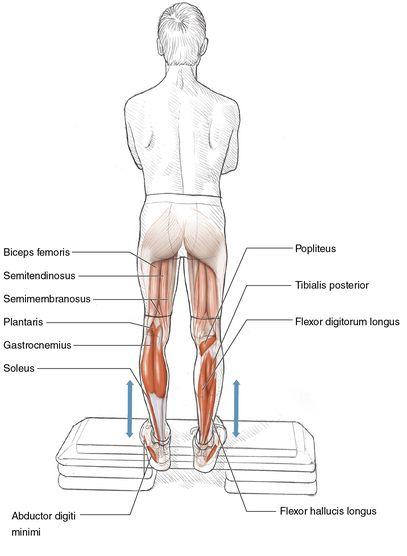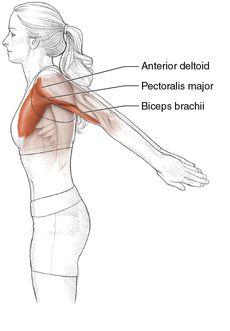Stretching Anatomy-2nd Edition (25 page)
Read Stretching Anatomy-2nd Edition Online
Authors: Arnold Nelson,Jouko Kokkonen
Tags: #Science, #Life Sciences, #Human Anatomy & Physiology

Execution
- Stand upright with the right heel 1 to 2 feet (30 to 60 cm) ahead of the left toes.
- Keeping the right knee straight and the left knee slightly bent, bend the trunk over toward the right knee.
- Reach the hands toward the right foot.
- Do the stretching in a dynamic manner by bobbing.
- Repeat this stretch for the opposite leg.
Muscles Stretched
- Most-stretched muscles:
Right semitendinosus, right semimembranosus, right biceps femoris, right gluteus maximus, right gastrocnemius, lower right erector spinae - Less-stretched muscles:
Right soleus, right plantaris, right popliteus, right flexor digitorum longus, right flexor hallucis longus, right tibialis posterior
Stretch Notes
When you start participating in a sport and do not stretch properly, you are more likely to have your hamstrings tighten up. Tight hamstrings are common among many athletes and those who participate in recreational activities. Tightness in these muscles can ease during exercise as the muscles get warmer, but when the athlete stops, the pain can return.
Tightness is often an indicator of minor or major muscle strains, a common occurrence mainly felt postexercise. In addition, muscle strength imbalances, in which the knee extensors are stronger or the gluteal muscles are weaker than the hamstrings, will also cause tightness. Thus, it is especially important to stretch properly after exercise because this is when the muscles are warm and more receptive to stretching.
This is the most common preexercise stretch for the hamstring and calf muscles. The hamstrings are used in most activities, and you might feel some discomfort in these muscles from your previous exercise session. In any type of fitness activity, minor aches and tightness in the hamstrings are possible. The optimal time to lightly stretch these muscles is just before you start another exercise session. In most cases, light dynamic stretches will relieve those uncomfortable symptoms, and you will feel so much better after engaging in these dynamic stretches.
For the best results, try to keep the right knee straight, and bend the torso directly from the hip. It is also important to keep the back as straight as possible. If you have tightness on the outer side of the hamstring muscles, turn the right foot slightly out and bend the head and trunk more toward the medial (inner) side of the right knee to increase the stretch of the biceps femoris. On the other hand, turning the right foot slightly in and bending the head and trunk more toward the lateral (outer) side of the knee will increase the stretch of the semitendinosus and semimembranosus muscles located on the inner side of the hamstring muscles.
Dynamic Plantar Flexor Stretch
Execution
- Stand upright on the edge of a stair or beam, with the midsection of both feet on the edge.
- Hold on to a support with at least one hand, and keep the knees straight.
- Lower the heels down as far as possible, and execute this stretch in a dynamic, bobbing manner.
Muscles Stretched
- Most-stretched muscles:
Gastrocnemius, soleus, plantaris, popliteus, flexor digitorum longus, flexor digitorum brevis, flexor hallucis longus, flexor hallucis brevis, tibialis posterior, quadratus plantae, flexor digiti minimi brevis, abductor digiti minimi, abductor hallucis - Less-stretched muscles:
Semitendinosus, semimembranosus, biceps femoris
Stretch Notes
This stretch is often performed after exercise, but it is also highly recommended as a preexercise stretch. The calf muscles are in heavy use most of the day. They take most of the load during walking, running, and jumping activities. Naturally they become overworked, which sometimes leads to serious problems such as tendinitis or even muscle tears. As a preexercise stretch, this dynamic stretch for the plantar flexors will alleviate some of the problems you might encounter as you exercise these muscles extensively. We recommend performing this stretch as a warm-up before doing any higher-intensity workouts. You should also add a postexercise static plantar flexor stretch to your overall training program.
It is more comfortable to do this stretch while wearing shoes. Always support the body. If the body is not supported, this could cause the muscles to contract and not stretch. Do not overstretch these muscles when doing this exercise. Start easy, and slowly progress to a higher intensity level.
Dynamic Trunk Lateral Flexion Stretch
Execution
- Stand upright with your feet shoulder-width apart.
- Let the arms hang down by your sides.
- With the help of your arms, bend your torso laterally back and forth in a dynamic manner. Move down and up your right side, with your right arm sliding down the right thigh toward your knee, followed by moving down and up on the left side, alternating between right and left.
- Allow all dynamic movement to take place on the lateral side of the trunk.
Muscles Stretched
- Most-stretched muscles:
External oblique, internal oblique, intertransversarii, multifidus, quadratus lumborum, rotatores
Stretch Notes
Trunk lateral flexion stretching movements are often used in regular routines for nonspecific sports activity. You bend your trunk regularly in different directions many times a day. Most likely you might feel some unusual tightness or soreness in these muscles and simply want to get relief from these discomforts. Twisting the trunk goes along with lateral trunk flexion. These two muscle movements involve the muscles of the trunk extensors, flexors, and lateral flexors. Improved range of motion of all lower-trunk muscles can increase the range of motion in trunk lateral flexion and improve performance in activities that involve any nonspecific sports actions.
These core muscle groups are also often used as stabilizer muscles that allow other muscles to apply force. Thus it is important to keep these muscles in good shape. If these muscles are not working to their full capacity, it will affect the function of the other muscles, and your activity level and performance will naturally decrease.
It is important to warm up these muscles before performing any type of trunk flexion movement. Executing this stretch in a dynamic (ballistic) manner will definitely be helpful. This also decreases the possibility of injury or discomfort in these muscle groups during activity.
Dynamic Trunk Rotator Stretch
Execution
- Stand upright with your feet shoulder-width apart; you can also do this stretch from a sitting position.
- Bend your elbows and place your hands close to your chest. Keep your arms in this position during this stretch.
- With the help of your arms, rotate your torso toward each side, back and forth in a dynamic manner.
- Keep the trunk upright, and allow the dynamic movement to take place in the trunk.
Muscles Stretched
- Most-stretched muscles:
Multifidus, rotatores, external oblique, internal oblique
Stretch Notes
The trunk is considered a core area of the body. Trunk rotation is a very common movement in many sports as well as in common household activities. You bend your trunk regularly in daily activities, perhaps hundreds of times a day. No wonder you might encounter some muscular problems in this area. In addition, numerous sporting activities such as golf, tennis, and throwing sports require twisting of the trunk.
Twisting the trunk involves the trunk extensors, flexors, and lateral flexors. Improved range of motion of all lower-trunk muscles can increase the range of motion in trunk rotation and improve performance in activities that involve these actions. Warming up these muscles before any type of trunk rotation movement will definitely be helpful. Executing this stretch in a dynamic (ballistic) manner will also imitate the specific movement patterns experienced in these activities. This would decrease the possibility of injury or discomfort in these muscle groups during the activity.
Dynamic Shoulder Flexion and Extension Stretch
Execution
- Stand upright with your feet shoulder-width apart and your arms hanging down next to your hips.
- Swing your arms forward and backward in a dynamic manner as far as you can through the full range of motion.
- Keep the trunk upright, and allow the dynamic movement to take place in the shoulder joint.
Other books
Unleashed: Volume 1 (Unleashed #1) by Callie Harper
Miss Delacourt Has Her Day by Heidi Ashworth
Natasha's Awakening by Melville, J. A
Hunt Me by Shiloh Walker
No Marriage of Convenience by Elizabeth Boyle
Unbidden (The Evolution Series) by Hughey, Jill
Traitor's Kiss by Pauline Francis
Violet Tendencies by Jaye Wells
Just Friends by Robyn Sisman
Making His Way Home by Kathryn Springer





